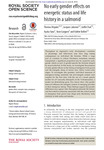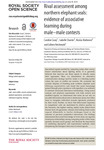Search
Now showing items 1-10 of 113
Can outcomes of dyadic interactions be consistent across contexts amongwild zebrafish?
(The Royal Society, 2015)
Winner–loser relations among group-living individuals are often measured by the levels of aggressive interactions between them. These interactions are typically driven by competition for resources such as food and mates. ...
Repeatability in the contact calling systemof Spix’s disc winged bat
(2015)
Spix’s disc-winged bat (Thyroptera tricolor) forms cohesive groups despite using an extremely ephemeral roost, partly due to the use of two acoustic signals that help individuals locate roost sites and group members. While ...
Light-emitting diode street lights reduce last-ditch evasivemanoeuvres by moths to bat echolocation calls
(The Royal Society, 2015)
The light-emitting diode (LED) street light market is expanding globally, and it is important to understand how LED lights affect wildlife populations. We compared evasive flight responses of moths to bat echolocation calls ...
Discrete but variable structure of animal societies leads to the false perception of a social continuum
(2016)
Animal societies are typically divided into those in which reproduction within a group is monopolized by a single female versus those in which it is shared among multiple females. It remains controversial, however, whether ...
Artificial light onwater attracts turtle hatchlings during their near shore transit
(2016)
We examined the effect of artificial light on the near shore trajectories of turtle hatchlings dispersing from natal beaches. Green turtle (Chelonia mydas) hatchlings were tagged with miniature acoustic transmitters and ...
Responsiveness to conspecific distress calls is influenced by day roost proximity in bats
(2016)
Distress calls signal extreme physical distress, e.g. being caught by a predator. In many bat species, distress calls attract conspecifics. Because bats often occupy perennial day-roosts, they might adapt their responsiveness ...
Signalling with a cryptic trait
(2016)
Sexual signals often compromise camouflage because of their conspicuousness. Pigmentation patterns, on the contrary, aid in camouflage. It was hypothesized that a particular type of pattern—barred plumage in birds, whereby ...
The importance of delineating networks by activity type in bottlenose dolphins (Tursiops truncatus) in CedarKey, Florida
(The Royal Society, 2015)
Network analysis has proved to be a valuable tool for studying the behavioural patterns of complex social animals. Often such studies either do not distinguish between different behavioural states of the organisms or simply ...
No early gender effects on energetic status and life history in a salmonid
(2015)
Throughout an organism’s early development, variations in physiology and behaviours may have long lasting consequences on individual life histories. While a large part of variation in critical life-history transitions ...
Rival assessment among northern elephant seals
(The Royal Society, 2015)
Specialized signals emitted by competing males often convey honest information about fighting ability. It is generally believed that receivers use these signals to directly assess their opponents. Here, we demonstrate an ...










